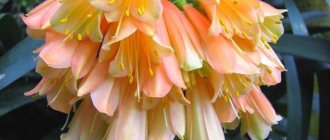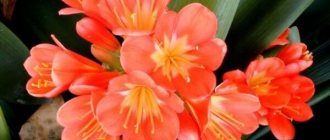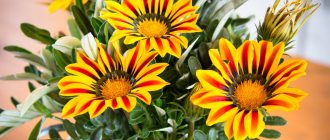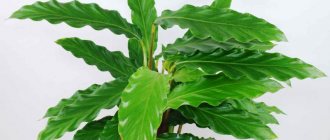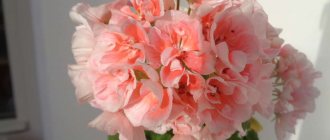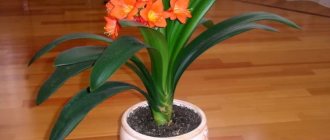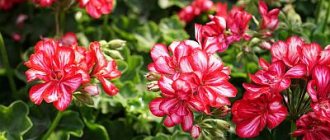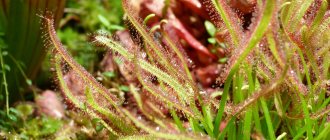The houseplant known as clivia belongs to the amaryllis family (hippeastrum, amaryllis, haemanthus). Clivia differs from its relatives primarily in the absence of a bulb - instead of it, clivia has leaves that are quite powerful and fleshy at the base, which grow like a braid and form a strong stem. Wild clivias can have huge stems. But such gigantism does not threaten the clivia room - there are other varieties here. Mostly Clivia nobilis and Clivia cinnabar grow on our windowsills.
Before the flowers appear, it is almost impossible to distinguish between these two species, except perhaps based on the fact that Clivia cinnabar can be larger, but any size is relative. Plants can simply be in different conditions and develop differently. So to determine the variety with accuracy you need to wait for the flowers. Clivia nobilis can have up to 40 or even 60 tube-shaped flowers on one peduncle. Clivia cinnabar boasts only 10-20 funnel-shaped, wide-open flowers.
Flower named after a woman
Clivia is a stemless indoor evergreen plant with long, dark green leaves. The false stem is formed from basal leaves tightly covering each other. Homemade clivias reach a height of about half a meter, the flowers of the plant are collected in umbrella-shaped inflorescences with a diameter of about 20 cm. Flowering lasts about a month.
In nature, clivia grows up to a meter in height.
The name of plants of this genus was given by botanist John Lindley. The flower was named in honor of Duchess Charlotte Clive, the governess of the future Queen Victoria, who was fond of floriculture. And one of the varieties of clivia was called Clivia Gardena, named after Major Robert Garden, who in the mid-19th century discovered a new species and brought it to Europe.
Clivia belongs to the amaryllis family. Under natural conditions, it grows in the humid subtropical forests of South Africa.
In its homeland, clivia is often used for medicinal purposes. However, you should be extremely careful at home: the sap of the plant is poisonous. You should not use it for self-medication.
Amateur flower growers often confuse clivia and wallot. Both plants belong to the same family and have similar leaf and flower shapes.
Table: clivia and wallota - how to distinguish them?
| Sign | Distinctive features | |
| Clivia | Vallota | |
| Root system | There is no bulb as such, instead there is a white and thick, fleshy rhizome. | The bulb is elongated-ovoid in shape with a massive neck. |
| Leaves |
|
|
| Flowers |
|
|
| Juice | If the leaf is damaged, yellow-orange juice flows from the wound. | Deprived of this feature. |
In general, keeping clivia at home does not cause much trouble. But it is worth knowing about the most comfortable conditions for it in order to provide the plant with maximum decorativeness.
Varieties
At home, three types of clivia are most often found: cinnabar, gardena and beautiful. Nevertheless, the flower is so good that new hybrid varieties are still being bred all over the world.
Table: distinctive features of various types
| Clivia variety | Peduncle height | Characteristics of flowers | Flowering time |
| Clivia cinnabar, or minium-orange (Clívia miniata) | 40–50 cm | Inflorescence in the form of a rosette with 10–20 flowers | February-May, but sometimes blooms at other times of the year |
| Clívia gardenii | 45–50 cm | 10–16 flowers | Second half of winter |
| Clivia beautiful, or noble (Clívia nobilis) | 30–50 cm | Inflorescence with 40–60 flowers | Second half of winter |
Clivia cinnabar turned out to be a very flexible plant, and on its basis more than a dozen new varieties with flowers of various colors were bred.
Photo gallery: Clivia cinnabar, also known as miniata, and other species
Clivia cinnabar blooms with bright orange-red flowers
A distinctive feature of Clivia Gardena flowers is their tubular shape and green tips.
Clivia Nakamura Red has bright red flowers.
Clivia citrina is a variety of Clivia miniata with creamy yellow flowers.
Clivia yellow is one of the hybrids bred on the basis of Clivia cinnabar
Clivia nobilis has drooping tubular flowers of red color with a white tip.
Common types of clivia
Indoor clivia flowers are represented by a small genus, consisting of only a few species. But, thanks to the work of breeders, many of their varieties have now been developed, with inflorescences of different colors: from pale yellow to dark red.
Clivia cinnabar (miniata, orange)
The basal rosette of Clivia miniata is formed from dark green, belt-shaped leaves tapering towards the top. Their length reaches sixty centimeters and width six. The umbrella inflorescence shown in the photo contains up to twenty red-orange flowers, sometimes with a bright yellow spot in their center.
The peduncle is quite strong and reaches fifty centimeters in height. Clivia cinnabar blooms in late winter or early spring. Of the varietal hybrids, the most interesting are plants with clearly defined stripes of white or bright yellow color on the leaves.
Gardena
Clivia Gardena grows up to fifty centimeters in height. The bright green leaves are sword-shaped and up to four centimeters wide. The plant differs from other species in its very narrow bell-shaped red flowers with greenish edges. Peduncles reach forty-five centimeters in height; at their top there are inflorescences containing from ten to fifteen flowers. Flowering occurs in winter.
Beautiful (noble)
Clivia beautiful differs from other species in its miniature size and grows no more than thirty centimeters in height. The belt-like foliage has fairly sharp edges. At the top of the flower stalks, which reach from thirty to fifty centimeters in height, there are up to forty pale red or yellow-orange drooping bells with a greenish edge, forming a large inflorescence. It usually blooms in winter.
Variegated
Clivia variegata (variegated) is the most spectacular, but at the same time very rare species. Its wide leaves are decorated with white longitudinal stripes (from three to ten). This enhances the decorative qualities of the plant; it is an excellent interior decoration even after flowering has ended.
The inflorescences of Clivia variegata usually consist of ten to twenty large flowers of bright orange color (up to 6 cm in diameter). They are located on the top of peduncles reaching fifty centimeters in height. Flowering occurs at the end of winter or the beginning of spring.
Air temperature and humidity
In spring and summer, clivia is kept at an air temperature of twenty to twenty-five degrees. At the end of flowering, when the plant enters the dormant period and throughout it, it is lowered to twelve degrees. After the clivia wakes up and a flower arrow forms, it is returned to normal conditions of detention.
Air humidity is not of great importance for the cultivation of clivia; the conditions of ordinary city apartments suit it quite well. Spraying is required only in the summer heat. But you need to wipe the leaves of the plant with a damp cloth regularly to remove accumulated dust.
Briefly about the conditions of detention
Caring for clivia does not cause any particular problems for gardeners. The most important thing for active development and flowering is to provide the flower with diffused light and a reduced temperature for rest in the autumn-winter season.
Table: what does a flower need to grow?
| Season | Temperature | Light | Watering | Top dressing | Air humidity |
| Summer | 20°C to 25°C | It is better to place the plant outside in partial shade. | Moderate, as the substrate dries | 1 time every 2 weeks | For clivia, this parameter is not important, so the leaves are washed more for hygienic reasons. |
| Autumn-winter (rest period) | 12°C to 15°C |
| Limited, from 1 time per week to 1 time per month | Not required | |
| Winter-spring (from the appearance of the peduncle) | 20°C to 25°C |
| Moderate, as the substrate dries | 1 time every 2 weeks |
Table: conditions for successfully growing plants indoors depending on the season
| Spring Summer | Autumn winter | |
| Lighting | Clivia loves good lighting, but on hot summer days it needs to be shaded from direct sunlight. Otherwise, clivia leaves may get burned. In summer you can take the plant out into the fresh air; it grows well both in the garden and on the balcony. | In autumn and winter, clivia tolerates partial shade well; it does not require additional lighting. |
| Temperature | The most comfortable temperature for the development of clivia during the active growing season is 20–25 ºC. | The plant requires coolness (12–15 ºC) starting in October. When clivia begins to wake up after a period of dormancy and releases a flower arrow, the temperature should be increased to approximately 20 ºC. |
| Air humidity | Humidity level does not play a significant role for clivia. It tolerates dry indoor air very well. When dust appears on the leaf blades, wash it off by wiping with a damp sponge. This amount of moisture will be enough for the plant. | Additional moistening of clivia is not required. |
How to care
Clivia is a plant that does not require special skills from the gardener. To ensure its comfortable growth, it is enough to follow the rules of watering and fertilizing, as well as create certain conditions during dormancy.
Watering
Clivia is a plant that does not like high soil moisture. Therefore, it should be watered only after the earthen ball dries out. Excess water from the pan should be poured out . If you neglect this rule, the roots of the clivia may rot.
When the plant enters the resting stage and the temperature in the room is reduced, watering is practically stopped; it is enough to moisten the soil once every 10 days. After flower stalks form on the clivia, the plant begins to be watered again as the soil dries out.
Tap water must be settled before watering. It is important that it is soft enough, without chlorine.
Air humidity is not important for clivia. Therefore, there is no need to spray it with a spray bottle . However, the plant is responsive to removing dust from the leaves with a damp cloth.
About once in the summer you can wash clivia in the shower.
Top dressing
Clivia is susceptible to fertilizing. They help it develop intensively and make it more decorative in appearance. Feeding should begin from the first year of life in the summer . Clivia should be fertilized during the period of growth and flowering once every 2 weeks, alternating organic and mineral products .
It is best to use organic fertilizers based on vermicompost. This could be Ideal, Giant, Breadwinner and others. To use them, 1 tablespoon of fertilizer is diluted in 2 liters of water.
Mineral complexes are diluted in warm water in a ratio of 2 g of fertilizer per 1 liter. The most commonly used are Ammophos, Kemira, Nitrophoska.
After the rest period begins (approximately from the beginning of autumn), feeding should be stopped and resumed when the flower shoots out the peduncle.
Nitrogen-based fertilizers can delay flowering. And complexes with a high potassium content have the opposite effect, stimulating the flowering of clivia.
Flowering time
Clivia usually begins to bloom in late winter or early spring and lasts about a month. When the flower arrow has become high enough (more than 10 cm), you should end the rest period and move the flower from an unheated room to a warm and well-lit place .
During flowering, you should increase watering of clivia and fertilize it regularly. For irrigation, it is better to take warm water, at a temperature 3–4 degrees above room temperature. If you do not start care on time, the flower stalk will be short and the flowering time will be significantly reduced.
After the clivia is placed in a bright place, the pot cannot be rearranged or even rotated.
What to do to make clivia shoot out a peduncle and bloom
Usually, the flowering of clivia is prevented by lack of rest . If you do not reduce watering and lower the temperature in autumn-winter, it is unlikely that you will be able to make clivia bloom.
When the arrow appears, the plant should be washed with warm water from the shower, increase watering and begin fertilizing. The first feeding is high in potassium (potassium chloride, potassium salt, potassium sulfate).
For the first time, clivia grown from shoots blooms in the second or third year. If propagation was carried out by seeds, the appearance of flower stalks should be expected no earlier than the fourth year of life.
If clivia does not bloom by this time, it needs a long rest. To do this, the plant is transferred to a low-light place with an air temperature no higher than 16°C for 3–4 weeks.
Another reason for the lack of flower stalks is that the pot is too spacious: the clivia will not bloom until the roots fill it completely.
When the clivia has faded and the peduncle is cut off: dormant period
It is important for Clivia to create conditions for rest in the winter. At this time, you can take the flower pot to a glassed-in loggia or another cool room. The main thing is that the air temperature should not be below +12°C, otherwise the plant may die.
The older the clivia, the more time it will take to rest. It is enough for young plants to rest for two months - from the end of September to November. When the age of the flower exceeds five years, the dormant period should be increased. From this moment on, clivia needs rest throughout the autumn-winter period - from mid-September to early February.
The rest period ends when the peduncle appears.
Can a plant bloom twice a year?
It is better to move the faded clivia to fresh air - a balcony or garden. The place for the plant should be shady and windless.
If you want to get the plant to bloom again this year, after a short break in nature, you should take the clivia to a low-light place and stop fertilizing, and also reduce watering to once a month. The leaves may begin to turn yellow, but there is nothing to worry about. In about a month, expect a new arrow to appear.
You can achieve flowering twice a year only from an adult and healthy plant.
Clivia propagation
Clivia from seeds.
How to grow clivia? There are generative and vegetative methods of propagating clivia. Anyone who decides to get seeds from their own clivia will have to resort to artificial pollination. If you can do this, we wish you good luck. For those who do not want to complicate their lives, it will be easier to buy seeds in a store. Growing clivia from seeds is preceded by soaking the planting material for swelling in water for a day, then the clivia seeds are sown in a mixture of peat and perlite (some prefer a mixture of sand with peat and turf soil) at about a centimeter depth. The distance between the seeds is about 2 cm. The container is placed in a greenhouse and kept at a temperature of 20-25 ºC, ventilated and moistened as necessary. Sprouts appear in a month and a half. After the first leaf appears, the seedlings are carefully planted in individual pots with a mixture of clay, humus and deciduous soil, and then annually transferred to larger pots. Clivia grows slowly - in the first year only two or three leaves develop, in the second year - three or four pairs of leaves, then two pairs of leaves per year. Clivia grown from seeds blooms in the fifth or sixth year.
Reproduction by lateral shoots.
The vegetative method of propagating clivia is much simpler than the generative method. When replanting an adult specimen that has faded this year, you only need to be very careful, so as not to damage the fragile root system, to separate the lateral shoots - clivia children - from the mother plant. Those that have already formed at least four leaves are suitable. The separated shoots are transplanted into pots with a diameter of 7 cm with sand and, placing them in a bright, warm place, they are cared for as an adult plant, with the only difference that they will need a little more heat and a little less moisture. In the third or fourth year, young clivias will bloom.
Errors in care
Despite the fact that Clivia is not capricious, various troubles can sometimes happen to it. It is important to know why they appear and how to correct them.
Table: why the tips dry out, the leaves turn yellow, brown spots and other visible defects appear
| External manifestation | Causes | What to do |
| The leaves are turning yellow | Natural aging, when old leaves die and new ones grow in their place | Does not require any measures |
| Insufficient or excessive watering |
| |
| Little fertilizer | Fertilize during the flowering period once every 2 weeks. | |
| If the plant is pollinated, the leaves turn yellow due to the redistribution of nutrients from the flower to the fruit. | Remove the fruits and peduncle when it begins to dry out | |
| Concerns such as transplantation, transfer or drafts | Move the potty only if absolutely necessary | |
| Brown spots on leaves | Sunburn | Remove the plant from direct sunlight |
| Pale leaf color | Lack of nutrition | Fertilize according to the rules |
| Leaves rot | The roots were damaged during transplantation | Watering is stopped until the earthen clod dries completely. |
| Brown tips of leaves | Excess moisture | Water more moderately, remove water from the pan |
Transfer
Before replanting a flower, prepare a nutrient substrate for it, consisting of equal parts of coarse sand, turf and leaf soil; add vermiculite to make the composition loose. Clivia does not like stagnant water, so you have to add so-called baking powder.
In cramped conditions, but not in offence! If the plant has become too cramped in the old pot, then the new one should be only a couple of centimeters larger in diameter than the old one. In fact, cramped conditions never stopped the flower from growing. In cramped “circumstances”, clivia, on the contrary, blooms even more magnificently.
A drainage consisting of expanded clay or broken brick in a thick layer is laid in the prepared flowerpot. Then you handle the plant, if necessary, separate the children. Add fresh substrate to the new pot along with a lump of earth, filling the resulting voids. This gentle method causes the least damage to the roots of the plant. In general, unless absolutely necessary, do not move the plant into a new container, it does not like it.
Diseases and pests
Pests rarely bother clivias, but in order to deal with them, it is important to notice the onset of an attack in time and prevent them from multiplying. If there are too many pests, it will be very difficult and sometimes pointless to fight them. The most common enemies of clivia are scale insects and mealybugs, rot .
The scale insect, also known as the shield aphid, has a protective waxy shield that protects the body of the pest. Adult aphids are motionless, but the larvae can crawl throughout the flower. Mealybugs form colonies.
Photo gallery: enemies of clivia
A sign of scale insects is red sticky spots and brown plaques on the leaves.
Mealybug forms a cottony coating on the leaves
The most common disease of clivia is rot.
Table: flower treatment for diseases and pests
| View | What does it look like | What to do |
| Scale insect (shield aphid) | Dark spots-growths on leaves | The larvae are destroyed by washing the flower with a soap solution (a small amount of kerosene or denatured alcohol can be added to it for effectiveness). Adults are removed with a damp soapy swab, but after this the plant must be sprayed with an insecticide. |
| Mealybug | Looks like white cotton wool on the leaves | A small number of pests can simply be removed with a damp swab, but if there are too many of them, it is necessary to spray the clivia with an insecticide weekly until recovery. |
| Rot | The leaves turn yellow, the plant begins to die | The reason is most often damage to the roots, so damaged roots should be cut off, the sections should be sprinkled with crushed coal and the plant should be transplanted into new soil. |
Soil contamination is the most common cause of pests and diseases, so do not forget to disinfect it before planting or replanting.
Reviews from flower growers
My flower calmly tolerates all changes, although I read that he does not like to be moved. I water like everyone else - once a week in winter, twice a week in summer. I try not to overfill. Universal fertilizer. Periodically you need to wipe the leaves from dust. Not only because the plant looks ugly, but also because it is harmful for it. You can sometimes spray, but this is not important. My mother and I have clivias that live for 5-6 years, mine has been blooming for 3 years, but for some reason it still hasn’t for her. This is a mystery to us.
Bastet
https://citykey.net/review/kliviya-krasivyy-komnatnyy-tsvetok
...Clivia is an almost problem-free flower! Clivia can bloom with yellow-white, bright orange or red flowers, somewhat reminiscent of bells. And these flowers are not single, but are in inflorescences, often there are about thirty flowers at once! Extraordinary beauty! This plant does not require moisture, only sometimes I spray its leaves and wipe them to remove dust. But when clivia blooms, it is better not to move or rotate the pot with it at all. And replanting should only be done when the roots are visible from the drainage holes below.
Murmur
https://spasibovsem.ru/responses/tsvetok-s-krotkim-nravom.html
Hello, my dear flower lovers! The other day my orange beauty Clivia blossomed. She is so bright and sunny! Twice a year it pleases me with its flowering. She “lives” on the balcony. Only in the hot summer months do I bring it into the room and place it on the windowsill.
irulchik
https://myfl.ru/category/nazvanie-rasteniya/kliviya-0
They gave me this flower for my birthday (7 years ago). I generally love flowers, but this one immediately sank into my soul, thanks to its stunning flowers. Over the years, I have independently determined how to properly care for him, since there are some subtleties in this. So, tips for caring for clivia: 1) It likes watering only when the soil dries out... 2) When a peduncle appears, it is advisable to water it a couple of times with warm water (about +40 +50 degrees) - this will help the peduncle grow higher and rise above sheets. 3) After it flowers, wait 2-3 weeks and cut off the peduncle - this is important!!! - replant the flower. Take it out of the pot, cut off the roots a little (I cut it with a knife)... If you do this, I guarantee that your flower will bloom for the second time in a year! 4) Location - east window only. On other sides of the world it grows worse and may not bloom at all. Flowering, by the way, lasts almost 20–25 days. For me - once every six months. And he also gives children. Definitely recommend!
vergo
https://irecommend.ru/content/moe-oranzhevoe-chudo-0
Description
A bush with dark green leaves that grow fan-shaped from a basal rosette and without flowers will decorate your interior, and with proper care the plant produces 5-6 young leaves every season.
Clivia blooms in winter: from the center of the leaf rosette grows a large, umbrella-shaped peduncle with 7–15 flowers in the form of tubes and bells.
The color palette of this crop is very wide and depends on the variety and variety of the plant: starting with ocher and ending with burgundy with all shades of yellow and orange.
